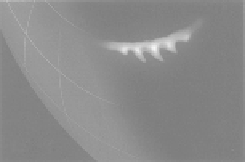Geoscience Reference
In-Depth Information
somemagnetospheric instability (e.g., Kelvin-Helmholtz) that causes undulations
(Kelley, 1986). Yamamoto et al. (1994) have simulated this process with the
results shown in Fig. 10.4b. The similarity with the data is striking. Another
suggestion is that kinetic drift waves driven by the ion temperature gradient in
the magnetosphere are the source of these features (Lewis et al., 2005). The lat-
itudinally elongated smaller-scale structures of sub-arcs in the bottom panel of
Fig. 10.4a suggest a set of thin field-aligned current sheets coming in and going
out of the ionosphere.
Radar observations of plasma at the poleward edge of the ionospheric trough
also show that it is often structured. One example of the latitudinal structure of
this region is given in Fig. 10.5, which shows the development and meridional
motion of enhancements in the F-region plasma density. Initially there is a dense
E-region layer beneath the F-region structure, indicating that it is collocated
with precipitating electrons. As the plasma blob drifted equatorward, the plasma
density became quite low in the E region below it. A plasma trough separates
60°
45°
Diffuse auroral pattern
T
5 1200 s
T
5
1200 sec
T
5
1500 s
T
5
1500 sec
768
x
T
5 1650 sec
T
5 1650 s
0
384 km
2688 km
y
(a)
(b)
Figure 10.4b
(a) Simulation of the temporal evolution of the distribution of the diffuse
aurora on the poleward edge of the trough. (b) A three-dimensional picture of giant
undulations with imitative color, obtained by projecting the computer-produced auroral
pattern (a) onto the globe surface. [After Yamamoto et al. (1994). Reproduced with
permission of the American Geophysical Union.] See Color Plate 27.







Search WWH ::

Custom Search